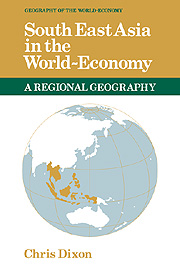Book contents
- Frontmatter
- Contents
- List of figures
- List of maps
- List of tables
- Acknowledgements
- Sources and place names
- List of abbreviations
- 1 Contemporary South East Asia in the world-economy
- 2 Pre-colonial South East Asia
- 3 Western penetration: from trade to colonial annexation
- 4 Uneven development: the establishment of capitalist production
- 5 Development strategies and the international economy
- 6 South East Asia in the late twentieth century: problems and perspectives
- Notes
- References
- Index
4 - Uneven development: the establishment of capitalist production
Published online by Cambridge University Press: 22 September 2009
- Frontmatter
- Contents
- List of figures
- List of maps
- List of tables
- Acknowledgements
- Sources and place names
- List of abbreviations
- 1 Contemporary South East Asia in the world-economy
- 2 Pre-colonial South East Asia
- 3 Western penetration: from trade to colonial annexation
- 4 Uneven development: the establishment of capitalist production
- 5 Development strategies and the international economy
- 6 South East Asia in the late twentieth century: problems and perspectives
- Notes
- References
- Index
Summary
Introduction
The territory acquired by the European powers before the nineteenth century retained the long-established relations of production. During the course of the 1800s and, most particularly, after 1870, capitalist relations of production were increasingly exported to South East Asia. Consolidation of control over the areas where these relations were being developed was both a necessary and integral part of the process. As we have seen in the case of Thailand, ‘control’ did not necessarily imply annexation. The crucial elements were the reserving and opening up of areas to the activities of metropolitan capital.
The growth of trade and production
The broadly based pattern of trade and production that existed prior to Western annexation of South East Asia underwent rapid and profound change. In general exports became narrowly based and oriented almost exclusively towards the needs of the individual colonial powers. The trade in high-value scarce products such as spice was supplemented, and later eclipsed, by the mass production of lower-value products. Many of these were long established in the region, such as teak, tin, coconuts, fibres and rice. Others were new: oil, rubber and palm oil. This process was initiated by the Dutch who began the large-scale export of sugar, coffee and later indigo from Java during the seventeenth century. These products rapidly supplanted spice in the VOC trade (Tate, 1979: 36).
- Type
- Chapter
- Information
- South East Asia in the World-Economy , pp. 85 - 148Publisher: Cambridge University PressPrint publication year: 1991



